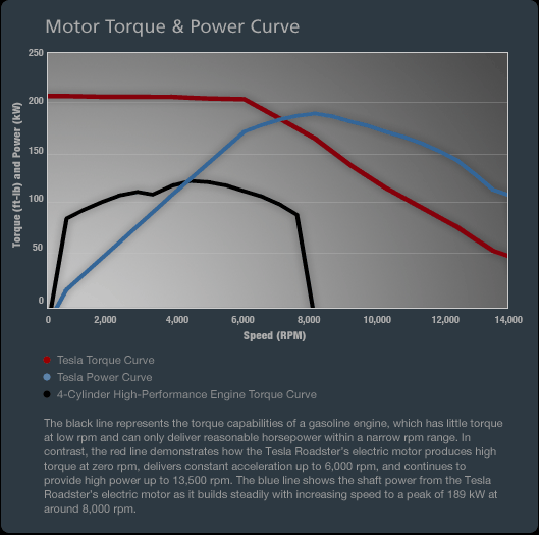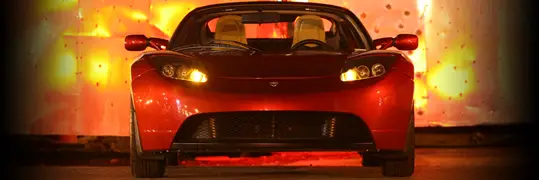
Tesla Electric Cars
• 100% electric
• 0-60 mph (100kph) in 4 seconds
• 135 mpg (217kms) equivalent
• Over 200 miles (321kms) per charge
• Less than 2c per mile
A well-to-wheel efficiency analysis of the Honda FCX ( hydrogen fuel cellvehicle) shows that the Tesla is 3 times more efficient and produces one third of the CO2 emissions!
See Also the pages on Hybrid Electric Vehicles (HEV), Plug-in Hybrid Electric Vehicles (PHEV), and converting your own car to electric.
Tesla Electric Cars – How They Work
When a car is electric, there is one built-in advantage: Electric cars just don’t have to be as complex mechanically as combustion engine types. Sophisticated electronics and software take the place of the pounds and pounds of machinery required to introduce a spark and ignite the fuel that powers an internal combustion engine.
For example, the typical four-cylinder engine of a conventional car comprises over a hundred moving parts. By comparison, the motor of the Tesla Roadster has just one: the rotor. So there’s less weight to drive around and fewer parts that could break or wear down over time.
But according to Tesla the comparison doesn’t end with the counting of moving parts. The engine and transmission of a conventional car also need lubricating oils, filters, coolant, clutches, spark plugs and wires, a PCV valve, oxygen sensors, a timing belt, a fan belt, a water pump and hoses, a catalytic converter, and a muffler — all items requiring service, and all items that aren’t needed in an electric car.
The Tesla Roadster’s powertrain consists of just the four main components discussed below. Mind you, these aren’t “off-the-shelf” components, and each includes innovations, both small and large. But when building a car from the ground up, there is the luxury of questioning every assumption — and to distill as it is reinvented.
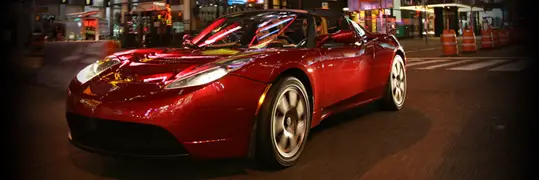
The Energy Storage System (ESS)
Tesla set out to build a high-performance electric car, and the biggest challenge was the battery. Its complexities are clear: it’s heavy, expensive, and offers limited power and range. The Tesla Roadster’s battery pack — the car’s “fuel tank” — represents the biggest innovation in the Tesla Roadster and is one of the largest and most advanced battery packs in the world.
They claim to have combined basic proven lithium ion battery technology with a unique battery pack design to provide multiple layers of safety. In the Tesla electric cars the batteries are light, durable, recyclable, and capable of delivering enough power to accelerate the Tesla Roadster from zero to 60 mph in approximately 4 seconds. The battery stores enough energy for the vehicle to travel over 200 miles without recharging.
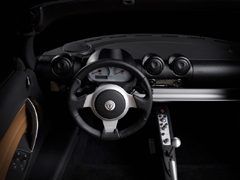 Motor
Motor
It is hard to imagine the acceleration coming from a motor about the size of a watermelon. Most car engines have to be moved with winches or forklifts. Motors for Tesla electric cars weigh about 70 pounds. More importantly than the motor’s size or weight is its efficiency. Without proper efficiency, a motor will convert electrical energy into heat instead of rotational energy. Tesla designed a motor, which claims to have efficiencies of 85 to 95 percent. This means more energy is available for propulsion instead of simply generating heat. 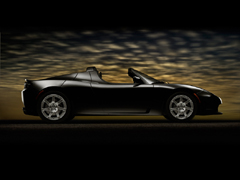 Transmission
Transmission
Tesla electric cars have a transmission that couples the fuel efficiency of a manual with the driving ease of an automatic. The Tesla Roadster has only two forward gears, allowing fining tuning of the driving experience (but either gear will work for most driving scenarios). Unlike a manual transmission, the car will not stall if you have it in the wrong gear. There’s also no clutch pedal. Just move the lever and the electronic control module takes care of the shift, so you can launch from a full stop to freeway speed without taking your focus off the road, your foot off the accelerator, or your hands off the wheel.
Power Electronics Module (PEM)
Most of the subsystems in the Tesla Roadster are completely electronic and under direct software control. But unlike all other cars, these systems are not a hodge-podge of independent systems — instead, they are designed as an integrated system, the way complex network and computer systems are designed today.
The Power Electronics Module (PEM) is the network hub of all Tesla electric cars. When you shift gears or accelerate in the Tesla Roadster, the PEM translates commands into precisely timed voltages, telling the motor to respond with the proper speed and direction of rotation. The PEM also controls motor torque, charging, and regenerative braking, and it monitors things like the voltage delivered by the ESS, the speed of rotation of the motor, and the temperatures of the motor and power electronics.
The PEM controls over 200 kW of electrical power during peak acceleration — enough power to illuminate 2,000 incandescent light bulbs. Most of us could not afford this performance vehicle, however let’s hope the technology flows through to the lower end market, and the electric cars are recharged with renewable energy.
Production
More than 1,000 customers have ordered the $98,000 2008 Roadster, according to the company. The estimated base price for the 2009 Roadster is $109,000. Final pricing will be announced just prior to the start of 2009 production. Tesla started production, making one or two cars a week, but it says it will steadily increase production to around 100 cars a month by early 2009.
OK.. this form of electric transport is beyond the reach of most of us, but there are other forms… why not try an electric scooter?
